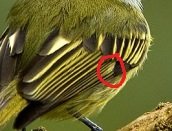TomFriedel
Well-known member

This bird was seen in varzea forest in Leticia, Amazonas, Colombia.
Offhand it looks like it could be a Grey-crowned Flatbill. It was seen near an active nest with this bird
that has more white, but similar wing bars.
My understanding had been that the Zimmer's Flycatcher shows the least wingbars of the flatbills, and that the Pacific version, Yellow-margined Flatbill has no wingbars at all, just yellow edges to the wing feathers. That Zimmer's has slight wingbars is based on illustration in the ProAves field guide, and a photo of Zimmer's from someone I trust. And the Yellow-olive Flatbill looks more like this: Yellow-olive Flatbill | BirdPhotos.com
On the BOW Cornell page the Yellow-Olive Flatbill photo to me could not possibly be that species because it has no wingbars. Maybe this is a difference in an Amazon subspecies as I understand it, and I am guessing it is just citizen science at it's worst. The wingbars in these photos look to me like Zimmer's or Grey-crowned, but not Yellow-olive.
I always look for some black in the lower mandible of Grey-crowned, and don't see that here, making me think this could be Zimmer's.
The nest was woven underneath a palm leaf 3-4 meters above the ground. Most flatbill nests I have seen are hanging.
thanks, and I hope this post came out ok, there is virtually no Internet here.
Yellow-olive Flatbill | BirdPhotos.com
www.birdphotos.com
Offhand it looks like it could be a Grey-crowned Flatbill. It was seen near an active nest with this bird
Yellow-olive Flatbill | BirdPhotos.com
www.birdphotos.com
that has more white, but similar wing bars.
My understanding had been that the Zimmer's Flycatcher shows the least wingbars of the flatbills, and that the Pacific version, Yellow-margined Flatbill has no wingbars at all, just yellow edges to the wing feathers. That Zimmer's has slight wingbars is based on illustration in the ProAves field guide, and a photo of Zimmer's from someone I trust. And the Yellow-olive Flatbill looks more like this: Yellow-olive Flatbill | BirdPhotos.com
On the BOW Cornell page the Yellow-Olive Flatbill photo to me could not possibly be that species because it has no wingbars. Maybe this is a difference in an Amazon subspecies as I understand it, and I am guessing it is just citizen science at it's worst. The wingbars in these photos look to me like Zimmer's or Grey-crowned, but not Yellow-olive.
I always look for some black in the lower mandible of Grey-crowned, and don't see that here, making me think this could be Zimmer's.
The nest was woven underneath a palm leaf 3-4 meters above the ground. Most flatbill nests I have seen are hanging.
thanks, and I hope this post came out ok, there is virtually no Internet here.





